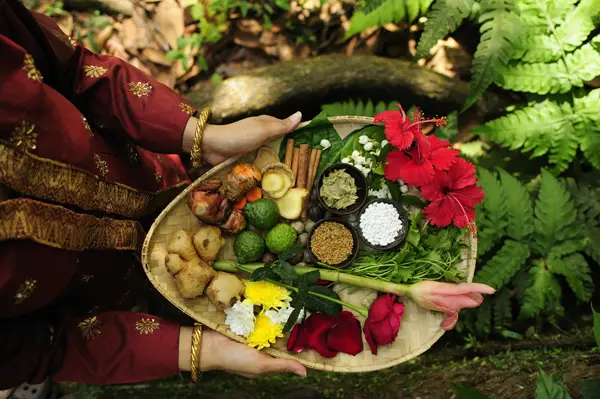Biodiversity and Health
Gerald J. Joseph, B.S., M.Ed. HealthCoach
Getting a cold? Take some echinacea. Feeling stressed? Try a little ginseng. Worried and depressed? Perhaps some St. John’s wort will pick you up? According to Bob Stanley, the growth in popularity of these and hundreds of other herbal remedies in Europe and North America has created a multi-billion dollar industry over the past two decades — $27 billion in the US alone in 2001.
While the trend may be new, most of these “alternative medicines” are not as compared to your grandparent’s cures. Some are effective, some are not. Most, though not all, are at least harmless as recent research suggests, however, that plant-based medicines — phytomedicines — may be the key to improving health outcomes of some of the world’s most serious diseases.
In developing countries, traditional herbal remedies are far from a trend. Widely used for millennia, they continue to be the first line of health care for most of the population and growing in popularity in the USA.
What I am taking about are “phytomedicines.” These were the pharmacologists, who use the term to describe their research into plant-based medicine. The prefix “phyto” comes from the Greek word phyton, meaning plant.
A 20-year-old statistic from the World Health Organization (WHO) suggests that 80% of the world’s people rely on traditional medicines and traditional systems of medicine for day-to-day health care. And there is little to suggest that this has changed during the two decades in which the people of the North have been rediscovering herbal remedies. [1]
Looking to nature for medicine is nothing new – we have been doing it for tens of thousands of years and although modern pharmaceutical science has come a long way from those ancient roots, nature is and will always be an important source of useful compounds and inspiration.
Dismissing nature in this regard is a huge mistake as evolution is the greatest problem solver and the myriad compounds produced by the immense variety of species we share the planet with have been honed by three billion years of trial and error. However, with every bit of habitat that disappears under the plough or concrete we impoverish nature and deprive ourselves of potential medicines.
The preservation of biodiversity is perhaps the single most important building block for achieving the Sustainable Development Goals set by the United Nations. For many of these goals, the importance of preserving biodiversity is obvious, 1) Zero Hunger), 2) Climate Action), 3) Life below Water, and 4) Life on Land.
This argument holds true for the other global goals including, but not limited to, 1) Good Health, 2) Well-being, 3) Reducing Inequalities, 4) Responsible Consumption and Production. Preserving biodiversity in many landscapes and natural habitats free for people to enjoy and access both locally and worldwide, rather than only in museum collections and zoos is critical for understanding life, the workings of the biosphere and for developing methods to sustain the quality and longevity of human life. Of comparable importance, access to biodiversity as a living, evolving aspect of our planet has the potential to increase the public’s appreciation for these systems and processes.
The sustainable development of natural products will not be possible without taking biodiversity conservation into consideration. While plants are commonly used for medicinal purposes, new possibilities are emerging from organisms that are incredibly diverse biologically and chemically, but relatively understudied, such as arthropods and fungi, particularly in many countries deemed as ‘biodiversity hotspots’ [2]
We can be certain that we share the planet with an enormous variety of species. A very recent estimate of 1-6 billion species is certainly realistic when we take into account parasites, parasitoids and endosymbionts [3].
Human Disease & Biodiversity
Collecting, curating, and disseminating knowledge on biodiversity as it relates to the treatment of human diseases will promote the conservation of bio- and molecular diversity and, simultaneously, create the international cooperation needed to safeguard well-being for all communities. [4-7]
A new approach is beginning to take hold around alternative medicines, organic food sources, plant-based nutrition and forcing the entire medical community to grapple with certain questions: How has the role of a doctor changed over the years? Are there better ways to treat the kinds of health problems that can usually only be managed, not cured? And how do you gather evidence on therapies that involve not only the body but also the mind?
The bigger problem is that most doctors aren’t well equipped to treat chronic disease as we have an acute-disease system for a chronic-disease population, an approach is to suppress and inhibit the manifestations of disease.
When it comes to thee suppression approach makes sense when you’re trying to solve a sudden flare-up—a high fever, a migraine, or a constriction of the airways during an asthma attack, conventional medicine seams to be working but, when it comes to addressing chronic disease syndromes like heart disease, type II diabetes and obesity, which develops over time, doctors still don’t understand exactly what causes it, what to do about it and how to track patient populations to see if they are improving.
In conclusion, it is crucial that governments, global organizations, and local stakeholders come together to agree on preservation of remaining hotspots of biodiversity through development of partnerships with the medical communities.
I believe that modern medical doctors and research scientists are a highly adaptable professions, with new studies constantly challenging the conventional wisdom, they will come around to the power and use of nature and organic foods sources as preventative tools for our planet and for human health.
NATURE GOT IT RIGHT!
References
1) Biodiversity, drug discovery, and the future of global health: Introducing the biodiversity to biomedicine consortium, a call to action.
Vidushi Neergheen-Bhujun, Almas Taj Awan, Yusuf Baran, Nils Bunnefeld, Kit Chan, Thomas Edison dela Cruz, Dilfuza Egamberdieva, Simon Elsässer, Mari–Vaughn V. Johnson, Shoji Komai, Andrey L. Konevega, John H. Malone, Paul Mason, Rothsophal Nguon, Ross Piper, Uttam Babu Shrestha, Milica Pešić, Alexander Kagansky

